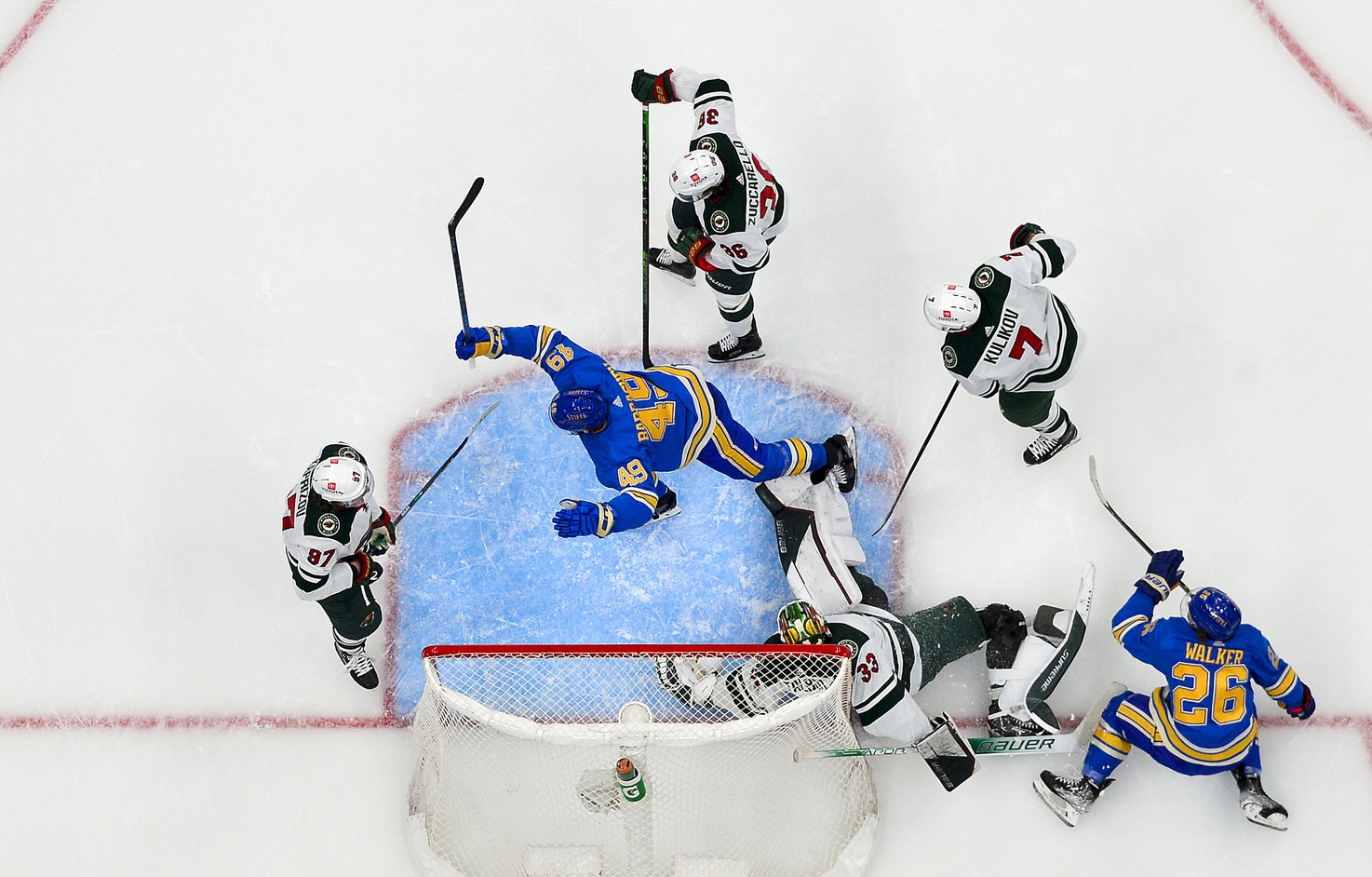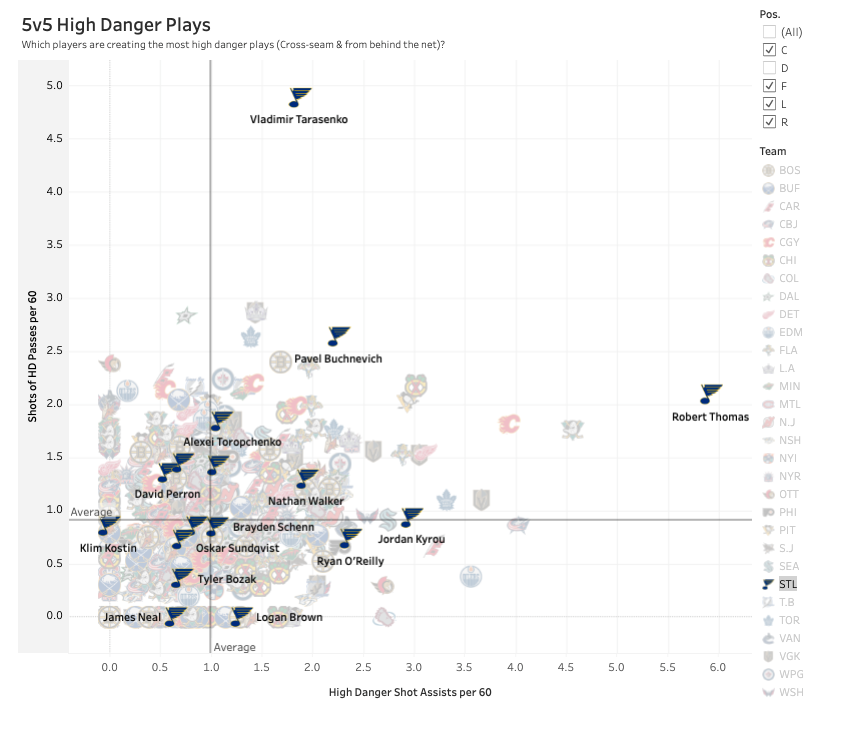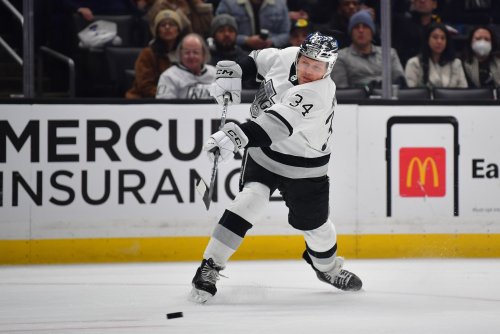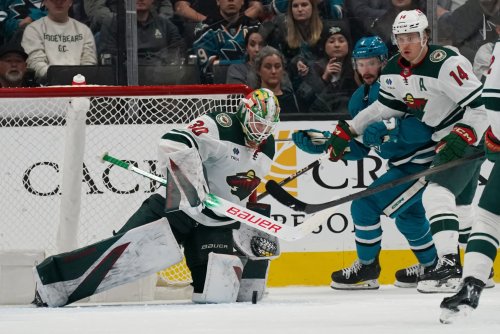
When most folks picture the St. Louis Blues, you know what you're going to get. A stout defensive team that isn't afraid to muck it up. Led by defensive-minded centers like Ryan O'Reilly, and David Backes before him, the Blues will lock you down while throwing a few heavy hits or extra punches along the way.
Or at least, that's how they played until very recently.
The Blues' defense started slipping during the COVID-shortened season. In 2019-20, they allowed just 2.20 expected goals per hour at 5-on-5, tied for seventh in the NHL. The following year, they dipped to 2.34, good for 15th league-wide. This year has seen the final crash of St. Louis' once-mighty defensive structure. They now sit tied with the Ottawa Senators for 25th-place, allowing a whopping 2.65 expected goals per hour.
That sounds like great news for the Minnesota Wild, who are on a crash course with St. Louis in Round 1. While a Blues defense that previously gave them fits collapsed, the Wild are still riding high. They're third in 5-on-5 scoring, seventh in allowing 5-on-5 goals, and second in allowing expected goals. On paper, they should buzzsaw this Blues team.
Or, at least, you'd think. But over the past two seasons, the Blues boast a 9-1-1 record against the Wild. In those 11 games, St. Louis out-scored their division rivals 51-31 — over 4.6 goals per game.
This isn't a blip on the radar, either. The Wild's 3.19 goals per hour at 5-on-5 may be third in the league, but the Blues are right behind them, with a 2.98 rate good for sixth in the NHL. St. Louis holds a slight advantage in all situations, with 3.72 goals per hour to Minnesota's 3.62. They basically equal, sitting at fourth and fifth in the league.
Minnesota has touted their depth all season, but St. Louis is even deeper, at least from a scoring perspective. The Blues have eight players who've eclipsed the 50-point mark, with just four for the Wild. Drop that threshold to 40, and St. Louis still holds an 11-6 advantage.
So perhaps it's no surprise that the Blues have torched Cam Talbot alive this year. The goalie has three games against St. Louis this year, where he's posted a ghastly .814 save percentage. That includes two post-trade deadline meetings, when Talbot's game improved significantly, where he surrendered 10 goals. Is this a small sample size? Sure. But Talbot struggled in five games against the Blues last season, as well, with an .891 save percentage.
Trade deadline pickup and Hall of Famer Marc-Andre Fleury had success against the Blues last season (.921 in 4 games), but St. Louis has made Fleury look ordinary this year. In three meetings, all with the Chicago Blackhawks, he went an unremarkable .903, allowing 10 goals in three games.
This is all despite the fact that, on paper, it doesn't make much sense that the Blues would own Minnesota's goalies so much. It sure looks like they're playing way over their skis, offensively. They currently have the highest shooting percentage in the NHL, both at 5-on-5 and in all situations. The thing is, though, they seem pretty mediocre at generating scoring chances. Evolving Hockey's expected goals model has them ranked 15th in the NHL at 5-on-5. Natural Stat Trick has them 25th in high-danger scoring chances per hour.
With that in mind, it's tempting, and maybe fair, to dismiss this as meaningless. A goalie's performance in a handful of games doesn't have too much bearing on what will happen in a seven-game playoff series. Last year, Talbot had an .898 save percentage against Vegas before carrying Minnesota to seven games, posting a .923 in the playoffs.
But just because something might be a small sample size, doesn't necessarily mean it's a fluke. Thanks to the incredible work of player tracker extraordinaire Corey Sznajder, we may have insight into a flaw St. Louis exposes with Minnesota.
Nobody in the NHL is better at passing around the slot than St. Louis. We're talking about two specific dangerous plays. The first kind are passes through "Royal Road" in the slot. Imagine a line that runs through the center of the ice, cutting the net in half. That's Royal Road, and if you can complete a pass from one side to the other, you've got a great shot at scoring. Not only are you taking a shot from the slot, which is fairly good scoring territory on its own, but you're making the goalie move, and much more likely to be out of position.
The next is the pass from behind the net to the slot. Again, you're making a goalie move, but this time, his eyes more than his body. Having to track the puck from behind the net to in front of it gives a goalie much less time to prepare and settle for an incoming shot.
Any Wild fan who's watched Kirill Kaprizov and Mats Zuccarello instinctively knows this, but a shot coming off one of these passes is way more likely to beat a goalie than a shot with no pass from the exact same spot. St. Louis leads the league in making these passes at 5-on-5. They do it about 5.6 times an hour at 5-on-5, or, almost two times more often than the Wild average in the same amount of time.
But why is this important if St. Louis still is mediocre at creating expected goals and scoring chances? Because one of the (acknowledged) weaknesses of expected goals/scoring chance/shot quality models can't account for passing. The data the NHL provides that makes it possible doesn't track it. So a shot that might appear to be medium, or even low-danger, might be extremely dangerous if it's preceded by the kind of pass St. Louis loves to make. Robert Thomas and Vladimir Tarasenko in particular feast on this type of play, but players like Pavel Buchnevich, O'Reilly, and Jordan Kyrou are also elite at weaponizing it.
[caption id=attachment_123573" align="alignnone" width="850] Courtesy of Corey Sznajder.[/caption]
Courtesy of Corey Sznajder.[/caption]
That, in part, explains both St. Louis' offensive explosion and why they've likely had Talbot's number. You see, Talbot is particularly weak against high-danger scoring chances. Among the 55 goalies with 1000-plus 5-on-5 minutes, Talbot ranks 41st with a high-danger save percentage (HDSV%) of .810, according to Natural Stat Trick. The one thing St. Louis does better than anyone is, unfortunately, a perfect match against Talbot's biggest weakness.
While Talbot's game has turned around since the trade deadline, his propensity to give up high-danger goals hasn't followed suit. He's posted an .804 HDSV% dating back to March 21st, 31st among 48 goalies with 300-plus minutes. There's little reason to think that St. Louis won't continue to exploit Talbot in the playoffs.
So what about Fleury, who the Wild acquired at the trade deadline? At first blush, he doesn't look much better off than Talbot against the Blues' high-danger passing attack. His HDSV% at 5-on-5 sits at .815 for the season, which is 34th in the NHL, and barely higher than Talbot.
The fundamental question that all Wild fans, not to mention the team, have to ask is: Was that the product of aging, or his environment. And unlike Talbot, there's some reason to think that his problem was the latter.
There's no doubt that Fleury didn't play to his standards on a woeful, hopeless Chicago team. Since joining Minnesota, though, he's joined Talbot in turning his game around. Through seven games, Fleury has a .921 save percentage. Talbot may out-perform him overall, but Fleury has one massive edge: He's no longer performing poorly against high-danger shots.
Ten games is a small sample, but since the trade deadline, Fleury is 12th in the NHL with an HDSV% of .851 at 5-on-5. That could be a blip on the radar, but it lines up nicely with how he performed with the Vegas Golden Knights last year. Playing behind Vegas' strong defensive structure, Fleury was sixth in the NHL with an .853 HDSV%. Expecting a 38-year-old to still play well against the toughest shots in hockey may be a tall order, but he did it at age-37 and is doing it now that he's back behind a strong defensive Minnesota blue line.
There's an intense debate heating up over which of the Wild's two goalies should get the lion's share of playoff minutes. Based on post-deadline merit, Talbot probably deserves the nod. A rough four games from Fleury has his overall Wild save percentage at .905. Since the trade deadline, Talbot simply out-performed Fleury with a .923 save percentage. Looking at it strictly through a match-up lens, though, the evidence points against Talbot facing the Blues.
Goaltending is the single biggest factor in any playoff series, and if a team is as well-equipped to exploit Talbot's flaws as St. Louis has proven they are, it's too big of a risk to rely on him in that spot. Now, can Fleury hold strong against this uniquely dangerous passing attack? We can't know for sure. But based on what both goalies have shown, it's a lot safer to bet on Fleury to take away the thing the Blues do best. If he can hold up, the Wild have a good shot at advancing to Round 2.
Expected Goal stats via Evolving Hockey, High-Danger stats via Natural Stat Trick. All team data is accurate as of April 22, all goalie data is accurate as of April 27.
Think you could write a story like this? Hockey Wilderness wants you to develop your voice, find an audience, and we'll pay you to do it. Just fill out this form.






Recommended Comments
There are no comments to display.
Join the conversation
You can post now and register later. If you have an account, sign in now to post with your account.
Note: Your post will require moderator approval before it will be visible.